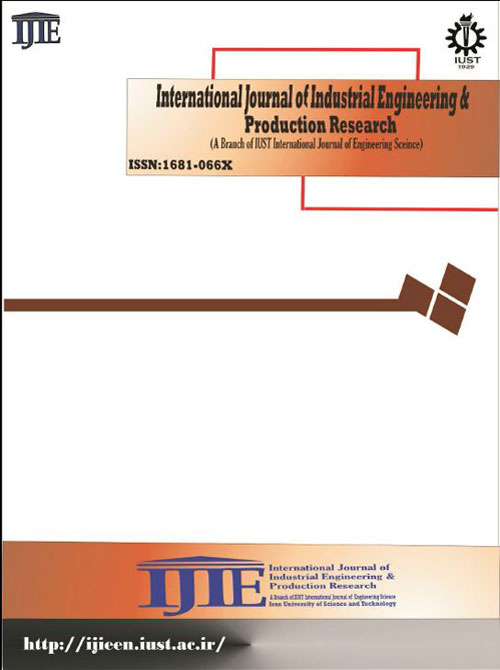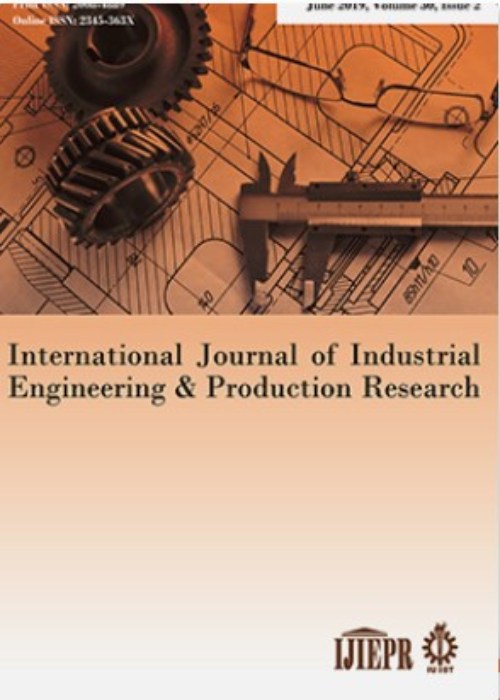فهرست مطالب

International Journal of Industrial Engineering and Productional Research
Volume:30 Issue: 1, Mar 2019
- تاریخ انتشار: 1397/12/10
- تعداد عناوین: 8
-
-
Pages 1-10Fully fuzzy linear programming is applied to water resources management due to its close connection with human life, which is considered to be of great importance. This paper investigates the decision-making concerning water resources management under uncertainty based on two-stage stochastic fuzzy linear programming. A solution method for solving the problem with fuzziness in relations is suggested to prove its applicability. The purpose of the method is to generate a set of solutions for water resources planning that helps the decision-maker make a tradeoff between economic efficiency and risk violation of the constraints. Finally, a numerical example is given and is approached by the proposed method.Keywords: Water resources management, Fuzzy numbers, Membership function, Fuzzy arithmetic, Fuzzy constraints, Two stage, Policy analysis, Uncertainty
-
Pages 11-23In the Wire EDM of oil hardening die steel materials is a complicated machining process. Hence to find out the best set of process parameters is an important step in wire EDM process. Multi-response optimization of machining parameters was done by using analysis called desirability function analysis coupled with the dimensional analysis approach. In the present work, based on Taguchi’s L27 orthogonal array, number experiments were conducted for OHNS material. The WEDM process parameters such as, pulse on time , pulse off time, input current, wire feed rate and the servo voltage are optimized by multi-response considerations such as material removal rate and surface roughness. Based on desirability analysis, the most favorable levels of parameters have been known. The significant contribution of parameters is determined by dimensional analysis. The experimental results show that the results obtain by using DA approach has a good agreement with the measured responses. The correlation up to 99% has been achieved between the developed model and the measured responses by using dimensional analysis approach.Keywords: Desirability function, Dimensional analysis, Multirespone Optimization OHNS Die Steel
-
Pages 25-37In this research a jobshop scheduling problem with an assembly stage is studied. The objective function is to find a schedule which minimizes completion time for all products. At first, a linear model is introduced to express the problem. Then, in order to confirm the accuracy of the model and to explore the efficiency of the algorithms, the model is solved by GAMS. Since the job shop scheduling problem with an assembly stage is considered as a NP-hard problem, a hybrid algorithm is used to solve the problem in medium to large sizes in reasonable amount of time. This algorithm is based on genetic algorithm and parallel variable neighborhood search. The results of the proposed algorithm are compared with the result of genetic algorithm. Computational results showed that for small problems, both HGAPVNS and GA have approximately the same performance. And in medium to large problems HGAPVNS outperforms GA.Keywords: Jobshop, Genetic Algorithm, Parallel Variable Neighborhood Search
-
Pages 39-55In today's world, natural disasters such as earthquakes, floods, crises such as terrorist attacks and protests threaten the lives of many people. Hence, in this research we present a mathematical modeling that provide efficient and effective model to locate temporary depot, equitable distribution of resources and movement of injured people to health centers, with the aim of developing the multi-objective model and considering multiple central depot, multiple temporary depot and several type of relief items in the model . This paper is considered certainty state and uncertainty of influencing parameters of the models in robust optimization for three different levels uncertainty and in different size with consideration of traditional goals function and humanitarian purposes functions simultaneously. The model has been solved with multi-objective Particle Swarm optimization algorithm (MOPSO) and GAMS software to validate the model. Some numerical examples are presented. In Addition, we present sensitivity analyzes of model and study the relationship of the number of temporary depot location and the number of injured people to move to health centers and the number of uncovered damaged points.Keywords: Humanitarian crisis management, multi- objective model, temporary depot location, robust optimization, multi-objective Particle Swarm optimization (MOPSO)
-
Pages 57-92In order to manage a project with integrity, a cohesive communication is needed between its various sections; possible risks, identification of stakeholders, providing the necessary resources on time and managing their availability, focusing on the approved budget and satisfactory quality the project can be successfully done. In the recent year BIM has as new aspects to engineering and architecture, and has become an accepted platform for planning and executing construction projects and contributed to integration of various fields and. also, project management standards, such as PMBOK, have come to aid construction managers. Through the basic capacities of BIM, and questionnaires according to aspects of PMBOK, the present study tries to identify the superior effects of BIM on project management. Moreover, it seeks to recognize the most significant aspects of BIM application on project management. by employing the FANP-AVIKOR decision making method to prioritize the parameters of the collected results, the study’s conclusion will indicate that almost all of PMBOK aspects equally benefit from using BIM; in addition, it will show that 3D BIM capacities, including clash detection, plan correction, are superior in comparison with 6D BIM and 7D BIM capacities.Keywords: Building Information Modeling (BIM), PMBOK Areas of Knowledge, Triangular Fuzzy Number, Analytic Hierarchy Process (ANP), VIKOR
-
Pages 93-103Financial decision-making is the principal part of any decisions hence great efforts are done to improve the methods to assess and analyze the stock in financial markets as a part of the financial decision. This paper addresses the stock selection by discovering investor's utility function .Investors in the Stock Exchange consider diverse criteria to buy shares and bonds. Due to the criteria development in stock selection, understanding the investor's behavior by a consultant is a prominent issue. Recognizing an exclusive utility function according to the characteristics of the investors facilitates acquiring each share's value for the decision maker (DM) when it is required. In this study, UTASTAR method is used to estimate the marginal value function, using 3 appropriate criteria (risk, return, liquidity) and finally fit out the total utility function. It provides the opportunity to make a rational decision fit to investor's mentality and allowing their ranking, prioritization, selection or classification. The ranking of the options is as compatible as possible to the original one. The method is applied to an example from Iran Stock Exchange.Keywords: UTASTAR, Multiple criteria decision aiding (MCDA), Utility functions, stock selection
-
Pages 105-115Supply chain members coordinate with each other in order to obtain more profit. The major mechanisms for coordination among supply chain echelons are pricing, inventory management, and ordering decisions. This paper concerns these mechanisms in a multi-echelon supply chain consisting of multiple suppliers, one manufacturer, and multiple retailers in order to study the price and leadtime competition, where the make-to-order production mode is employed and consumers are sensitive to retail price and leadtime. In the current study, a novel inventory model is presented, where the manufacturer has an exclusive supplier for every required component of its final product. The interactions and decisions of the firms are observed in multiple time periods. Moreover, each supply chain member has equal power and make their decisions simultaneously. The proposed model considers the relationships among three echelon supply chain members based on a non-cooperative Nash game with pricing and inventory decisions. An iterative solution algorithm is proposed to find Nash equilibrium point of the game. Several numerical examples are presented to study the application of the model as well as the effectiveness of the algorithm. Finally, a comprehensive sensitivity analysis is performed and some important managerial insights are highlighted.Keywords: Supply chain, Nash game, Make-to-order (MTO), Production planning
-
Pages 117-134In this research, a new bi-objective routing problem is developed in which a conventional vehicle routing problem with time windows (VRPTW) is considered with environmental impacts and heterogeneous vehicles. In this problem, minimizing the fuel consumption (liter) as well as the length of the routes (meter) are the main objectives. Therefore, a mathematical bi-objective model is solved to create Pareto's solutions. The objectives of the proposed mathematical model are to minimize the sum of distance cost as well as fuel consumption and Co2 emission. Then, the proposed Mixed-Integer Linear Program (MILP) is solved using the ε-constraint approach Furthermore, numerical tests performed to quantify the benefits of using a comprehensive goal function with two different objectives. Managerial insights and sensitivity analysis are also performed to show how different parameters of the problem affect the computational speed and the solutions’ quality.Keywords: Vehicle routing problem, Time windows, Fuel consumption, Co2 emission, ε-constraint, Environmental impacts


